[leadplayer_vid id="57C322E278CDC"]
Sometime I will remember to take a video when the thunder and lightening really gets going.
It can get very loud. And the lightening here flashes and spans the sky in ways I have not seen anywhere else.
Until late in August, it was not raining everyday. And when it rained it was typically raining for 1 to 2 hours in the afternoon.
But as we head into September, the rain is sometimes invading the morning hours.
Sometimes in November we can have days of rain.
If you are interested, I written more extensively about the rainy season and the overall climate in Panama.
For more on living in Panama, check out our blog and our frequently asked questions about Panama.

At the end of this article, I also briefly discuss remodeling a cement house.
I have spent my entire career building with wood: in Seattle, Alaska, even in Japan. So it seems strange for me to take such a strong stance against building with wood. Especially in Puerto Armuelles, which initially was built entirely with wood. The United Fruit Company, later Chiquita Banana, built Puerto Armuelles from the ground up using red cedar 2x4’s they shipped down from Portland Oregon.
I suppose if I were 36, or 46, rather than 56, I might feel differently. Or if I hadn’t already spent half of my life remodeling houses. Or if the weather were cool, as it is in Seattle, or Alaska.
I have met guys from various parts of the south, including Houston Texas who have told me that “Where I’m from it is 20 degrees hotter today”. These guys work in blue jeans in Panama. I have spent the better part of my adult life in the Pacific Northwest. On the hottest days in Panama, I sweat just standing still.
I guess what I am trying to convey is that it depends a great deal on the personality, and talents of the potential remodeler. If you are one of those men, or women, who has a tough time sitting still, or if you have looked forward to retirement so that you would have time for projects like remodeling an old Chiquita Banana house in Panama, then remodeling and old wooden house here might be just your cup of tea.
If you can pick up an historic, wooden Chiquita Banana house cheap and in good condition, it might be worth it. (Don’t forget to read the section on “termites” in my article on building with wood. Termites abound in coastal Panama, and they love to eat wood.)
Ten years ago wooden Chiquita homes in Las Palmas were going for $10,$20, $30,000. However, the current asking prices for the nicest homes in Las Palmas is in the $120k-$350k range. You can still pick up a deal, but the house is unlikely to be in good shape.
I would advise, as with any purchase in Puerto Armuelles, that you take your time, ask around. Eventually, you will find what you are looking for at a price that fits your budget.
In some of the less elite neighborhoods (that paradoxically are closer to the beach) deals are easier to come by. I think that, with patience, you still might be able to buy a wooden house in Carmen for under $14K, possibly even $11k. Carmen is a densely populated, working class neighborhood (noisy on the weekends). But Carmen is very well located on the ocean breakwater, at the south end of the downtown. The quality of the houses is already slowly improving in El Carmen, due to an inflow of new money into town. Many locals, even a couple of expats, are repairing and remodeling in Carmen. Prices can go nowhere but up.
Pressure treated 2x studs are available in David, imported from Canada and Chile, I believe. But they are expensive. At my last investigation, 2x6 pressure treated hem-fir cost over $2.00 per lineal foot. Prices may have come down, due to increasing demand; In the near future this may not be an unusual product anymore.
(Important note: I am not certain that I would want to live in a house made of such toxic wood, particularly if the framing lumber was left exposed. If that happens, the homeowner would end up in direct daily contact with the pesticide- impregnated wood.)
2. Labor cost. Another serious consideration when deciding whether or not to remodel a wooden house is labor cost.
On a per day basis, construction labor here in Puerto Armuelles is a steal. Workers get $20, $25, and $30 per day here. However, they don't have much experience working with wood. This means the efficiency level of these laborers is nowhere near a professional building crew in the States or in Canada.
A small 2 or 3 bedroom house that 2 skillful carpenters might frame in the States or Canada in a few weeks, could well take a crew of 6 men here several months to complete. And complete with a far lower quality of fit and finish. It is just not a woodworking culture.
There are those who would respond immediately “No Way. Don’t remodel a concrete block house. Far better just tear it down and start from scratch.”
I know from conversations with Milton Hutto, owner of Heavenly’s Hotel in San Vicente that he felt that he should have torn down the existing concrete house that became part of the West Wing of his hotel.
Most of his project was built using M-2, steel rebar, and concrete stucco. Obviously, Milton knows what he is talking about. He was there on-site during most of the construction, and he had prior building experience in Puerto Armuelles.
Watch a video of Milton talking about building a house in Panama, as an expat. Just click the link.
However, one should consider the scale of the project, before dismissing remodeling a concrete block house out of hand. In Milton’s case, he was building an 11 room hotel, not a small, single family, or single person dwelling. He employed a crew of at least 10 men. With this work force, costs were high, and quick progress was an absolute necessity.
Find out about building your house of concrete in Panama.
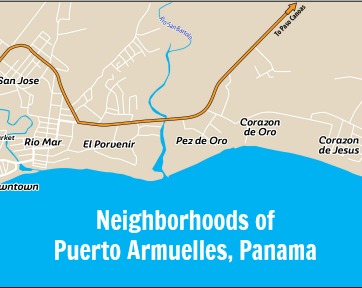
This map does not include all the neighborhoods in Puerto, but it show the ones of most interest to expats and retirees.
The map should help a visitor to more quickly get their bearings.
The 13 neighborhoods included on the map, going roughly from east to west:
Between downtown and Rio Mar is the Pueblo Nuevo neighborhood. It isn't shown on the map due to scale issues.
For information and photos of these neighborhood, click here.
The names of the rivers and creeks on the map are hard to read. So I am repeating them here.
Starting in the east, in the San Vicente neighborhood, and going west, the rivers are.
I will try to upload a higher resolution version of the map soon.
In the near future, I will have a map that includes the locations of restaurants, hotels, and other places of interest to people.
Want something shown on a Puerto Map?
Let us know.
If you want to know more about Puerto Armuelles, start here.
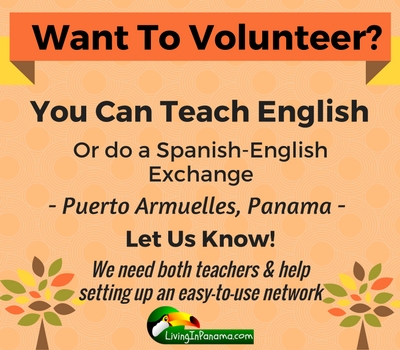
Or possibly an English-Spanish exchange network.
It would be a way for expat retirees to help young people in Puerto Armuelles improve their English.
As you can imagine, there are many more job and business opportunities open to Panamanians who speak English. It literally opens many doors for them here and internationally.
In Panama, where there is a wide gap between the upper class and the poor, helping a young person of modest means to improve their English skills might be the jumpstart they need to launch them, and their family, from the lower class into Panama’s growing middle class.
You really can make a difference in your world by volunteering to help another person. It is a satisfying way to maintain a grateful heart.
Not only is volunteering is a great way for expats to mix with locals, it is a an ideal way to practice your Spanish. And, of course, there is always the possibility of working out a trade: English lessons for Spanish lessons.
What’s more, you just might make a new friend for life. Who knows?
I am trying to get a rough idea of how many of our readers might be interested in participating in a language volunteer, or language exchange project. If you know someone who may be interested in volunteering, please let them know about our idea.
Is there anyone with a great organizational gift who would like to help with the logistics of setting up an easy-to-use system?
Please let us know. Send us an email, use our contact page, or comment below.
We welcome your suggestions, since this is new territory for us.
Thanks.
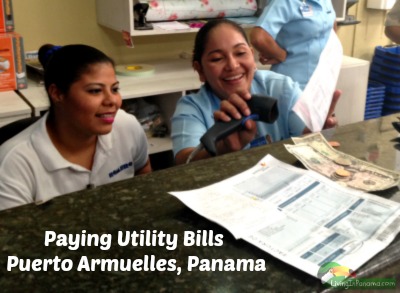
Ten years ago, we had to visit each individual utility office. Then wait in line to pay.
Sometimes the lines were long, and did not move fast.
These days, we simply take our bill to Romero’s grocery store where they have a counter dedicated to accepting utility bill payments.
In some parts of the country, mostly in or near Panama City, there are also Rapid Money and E-Pago kiosks in malls (as well as in supermarkets). You simply give the clerk the bill and pay them directly. Keep in mind that, Rapid Money payments can take several days to be credited. The E-Pago payments only take a few hours.
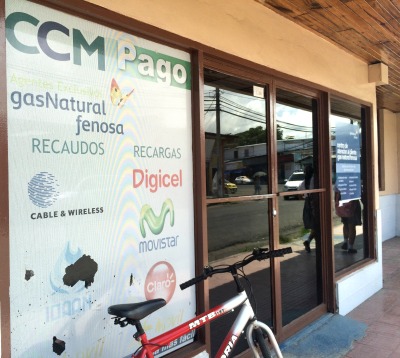
There is also a bill paying center in downtown Puerto Armuelles where you can pay all your bills (see photo)
You can also pay your bills online. You can initiate payment with your Panama bank or the utility company itself.
However, there can be a few requirements for paying online, depending upon the utility. For instance, some only accept payments from specific banks. If you don't have a bank account at one of those banks, you cannot pay online.
All our bills are hand-delivered by an employee of the utility company. If you are home, they will hand it to you. If not, they may leave it rolled up in your fence like they do at our house.
There is no home mail delivery in Panama, except for utility bills.
Luckily, the pay centers and utility companies also keep records of what you owe. So you don't need to have your bill in order to pay.
Make sure you get your bill stamped paid when you pay it.
These days the utility companies do a good job keeping track of your payments However, not always.
In the past, you could never count on your payments showing up in payment system.
If there is a problem, you will need to produce your paid - and stamped paid - bill. It will easier, faster, and result in fewer headaches and much less time spent if you do that.
In the case of garbage, a person comes to your house to collect the money. At least that is the only way I know that it happens in Puerto Armuelles.
The monthly garbage bill is only $3 in Puerto Armuelles. This month I paid through December and it only cost me $15. $15 for 5 months of garage sounds good to me. They pick the garbage up every Tuesday in our neighborhood.
Except for Internet, we pay all our utility bills in person. As I mentioned above, someone comes to our house to collect payment for garbage service.
I pay the rest of the utilities at the beginning of each month at Romero supermarket. When we are out of the country, we have someone else pay them for us.
In the case of our internet & phone bill, our service is through Cable and Wireless Panama. We pay it online using our bank account in the States.
We pay Cable & Wireless $35 a month for 4mbps Internet and a land line.
Internet Speed
Cable & Wireless will promise you a higher speed if you pay more. Don't believe them. That is their maximum speed, at least in our neighborhood of Puerto. Other Internet provider such as Cable Onda or Planet Telecom you can get 10mbps.
I still grimace to think about how horrible the experience was of having to wait in an interminable line at the Cable and Wireless office in Puerto Armuelles. This office used to only be open on Tuesdays and Thursday. Back then, Puerto didn’t have enough Internet customers to merit an office with regular daily hours, and Portenos were treated as if purchasing internet service were some sort of a grand privilege, rather than a business.
Now it is easy to do. We still don't have a Cable & Wireless office in town. Cable & Wireless has been at a stand still for the last 3 years. They haven't made any investments in their system due to the road construction (which keeps knocking out their lines) and the selling of their company. Cable & Wireless was finally sold about 2 months ago and the road expansion project is almost done. So perhaps Cable & Wireless will improve soon.
Luckily, new Internet companies are increasingly popping up these days. Companies that promise faster and better service. But faster and better service, I mean 10mbps and internet that does not cut out on a regular basis. We will have to write about it soon.
Find out what utilities cost in Puerto Armuelles, Panama.
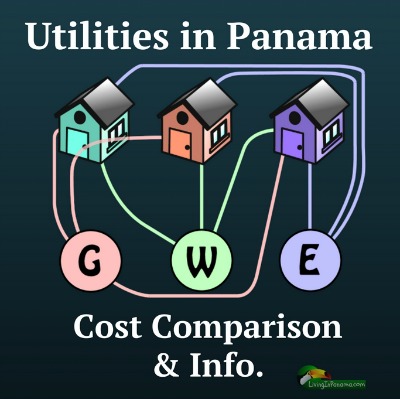
First of all, bill paying in Puerto Armuelles has not been a big preoccupation for us.
Bills here are so much lower than they are back in Seattle.
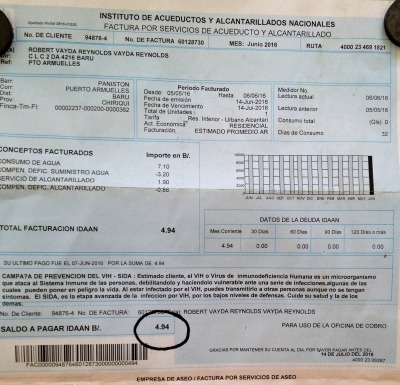
As you can see from the photo of the water bill (Instituto de Acueductos y Acantarillados or IDAAN), our water bill for June was $4.94, for unlimited water use.
By comparison, our water bill in Seattle is typically $150 per month in the winter, and up to $250 in summer. In Seattle, they charge you for the water both going in and going out of your house.
Our electricity bill in Puerto Armuelles is typically $35 per month. In Seattle, our summer electricity bill is about $300. Our highest winter bill was over $450 (we have electric heating).
We do not have air conditioning, but we are heavy users of fans and have a big and old refrigerator. We also have children who never remember to turn off a fan or light they are not using(!) You can see our electric bill below. Click on it to make it larger.
I looked up the electric rates in Seattle and Panama City to get a better comparison. 2 big cities.
Electricity in Panama has 3 rates, depending upon your use.
If you use less than 300 kWh, your rate is subsidized. Which is how some people have monthly electricity bills of only $4. If you use between 300- 750 kWh, you pay at a higher rate. If you use more than 750kWh, you pay at the highest rate. I couldn't figure out what that rate was, but that is the breakdown per kWh.
From conversations and reading, it seems clear that the rate charged at each of those kWh levels varies across the country.
Maybe it has something to do with whether your area is covered by Union Fenosa vs. Gas Natural Fenosa vs. the 2 electrical distributors (Empresa de Distribución Eléctrica Metro Oeste (Edemet), and Empresa de Distribución Eléctrica Chiriquí (Edechi) vs. Enca, which serves the northeast area of Panama
Gas Natural Fenosa of Spain is in charge of almost all the electricity in Panama though. Gas Natural Fenosa merged with Union Fenosa in 2009 and since then they bought 51% of the electricity distributors Edemet and Edechi. And they keep expanding. Perhaps all these subsidiaries and companies maintain separate rate structures? In Puerto Armuelles, the electricity bill (above) is issued by Gas Natural Fenosa, although everyone refers to it as Union Fenosa.
In general, if you use A/C all day every day, your electricity bill will likely be close to $300/month. If you use your A/C less, say just in your bedroom, your electricity bill will be more in the $100 to $150/month range.
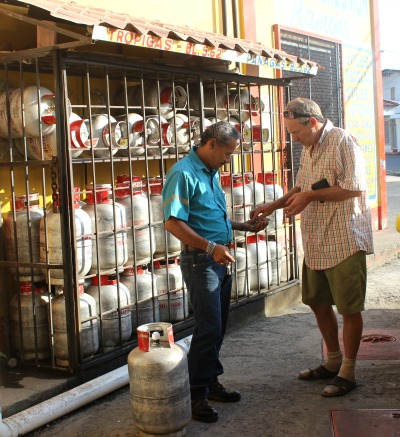
Our gas bill in Seattle is around $100/month. Here in Puerto, where there are no in-ground gas pipes, our bottled gas bill for our propane range/stovetop and our propane dryer is about $10/month. $5 a month for each bottle.
As you can see, compared to our costs in Seattle, we have substantial savings in our home utility bills in Puerto Armuelles.
Now for a question, I also get, "how to pay your utility bills in Panama". In that article about paying utility bills, I also give some information on a few other household bills such as
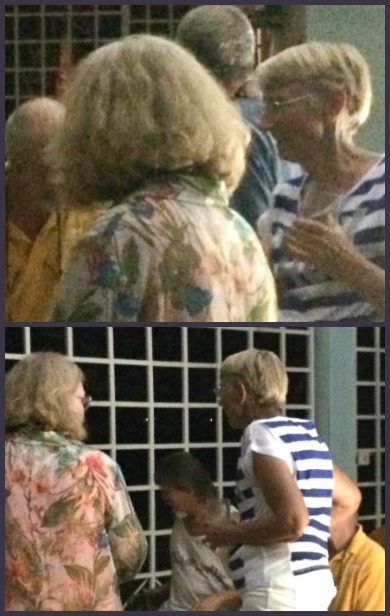
Loren rented a house in the Corazon de Jesus neighborhood of Puerto Armuelles for a few months.
She visited Puerto after spending over a year in Quito, Ecuador.
On her way out of town, Loren kindly wrote me about her experience and thoughts on living in Puerto Armuelles, Panama.
Since I am not within walking distance of downtown Puerto Armuelles, I take a taxi to and from the local market.
Shared Taxi Experience
Quite often when the driver stops for me, there are other passengers in the vehicle. The driver could just as easily pass me by, since he already has a fare. I especially appreciate his courtesy which gives me a chance to get out of the hot sun. This is quite a change from other places I have lived, where taxis pick up and deliver one fare at a time.
The interesting part of taking a shared taxi comes from discovering all the new places I get to see while we travel from Point A to Point B, which is often in the opposite direction from where I want to go. Along the way, we drop off the original passenger(s), perhaps pick up another passenger(s), then we might make an unscheduled stop for the driver.
Recently, I had one driver stop by his house to get more bottled water and on another occasion we first stopped by the driver's house so he could add water to his tank and fill the water dish for his chickens, lol!
This took about 5 minutes while I and another passenger waited in the car. Once that was done, we all headed to her destination and then back across town to my destination. So, for the same price, I get the Scenic Tour!
Everyone's Needs Are Equal & Respected
What this tells me is that this country respects the needs of all individuals. My need to get to the market is of no greater importance than the other passenger's need to meet her husband for lunch, nor greater in importance than the driver's need to take care of business at his home.
I like that about Puerto Armuelles ... there is the understanding that there is enough time for all things to get done and there is respect for all persons' needs.
Loren, thank you so much for sharing your thoughts on living in Puerto Armuelles.
If you want to share your experiences and views of Puerto Armuelles or Panama in general, please email them to me or use our contact form. We'd love to share your thoughts and experiences with others.
Or you can simply comment below.

The American channel, NBC, is broadcasting the Olympics.
NBC will "give" you 5 free minutes online. Then you must log in with your satellite or cable TV subscription info. Once you do that, if you have a subscription, you will then be told "this content is not available in your location".
Basically, if you are out of the USA, and want to watch the Olympics on NBC you cannot.
That is unless you, both:
You can skip all that by using USTVnow.com!
USTVnow was created for US Military and US Citizens living abroad. It is free.
A short aside:
You can also watch the Olympics with BBC online. This is new. Or at least new since the last time I tried. At one time I tried channels from a variety of countries to watch the Olympics. I was never successful (without a VPN). Also, it is interesting to watch the Olympics from BBC's perspective.
I will write about VPNs another time. But for now, "A VPN, or Virtual Private Network, allows you to create a secure connection to another network over the Internet. VPNs can be used to access region-restricted websites, shield your browsing activity from prying eyes on public Wi-Fi, and more." (by how-to geek)
I like the VPN, unblock-us. It is the best of all the VPNs I have tried. It is the only one that consistently and successfully fools TV and video sites that won't let me watch their content if I am out of the USA.
Back to USTVnow. Again, it was created for US Military and US Citizens living abroad. It is free.
Well you can pay money for more channels and to record shows, but the basics are free.
We don't own a TV so we watch everything online. Which is not much of an issue, except when you want to see something live. Like the Olympics or the World Cup.
I really wish we had known about USTVnow when we first came down to Panama. The Olympics were on then. I so wanted to watch, but could not. That was before I knew about USTVnow, or VPNs like Unblock-us, and more.
The Free Plan
With USTVnow's free plan, you get all the major stations that you would normally get free in the USA
For 45 days, you will see these channels in hi resolution on you computer or other devices (iPad, iPhone, Android and Roku). After 45 days, you will only be able to watch on your computer and it will be in low resolution.
The Paid Plan
If you pay, you get more channels, the ability to watch on other devices (ipad, etc), and the option to record shows. Supposedly, you also get high-resolution. But I have been on the paid plan from time to time and have not noticed a difference in resolution.
I have paid for USTVnow at times, for various reasons.
It was worth it to watch the World Cup. It was necessary when my mom visited. But the buffering issues during the debates were so annoying that I ended up simply watching the replays on Youtube the next day.
Cost
If you want all the channels USTVnow offers, it costs $19/mo for 1st 3 months. Then $29/mo.
If you want all the channels plus the ability to record, it costs $29/mo for 1st 3 months. Then $39/mo.
To see all the channels that they offer, visit USTVnow.
The easiest way to see the Olympics live and online, is to use USTVnow or BBC. USTVnow is a good option for anytime you want a USA TV fix, commercials included.
Betsy: Hi, Milton.
Milton: Good morning.
Betsy: I know that you have built a house or two and also this hotel, which we're seeing in the background, Heavenly's Hotel
What do you have to say about building a house here, for expats?
Milton: Building is relatively pretty easy.
The process of getting it done is not that bad. If you find you a good contractor, it’s a really smooth process.
Materials are very available to the standard. A lot of it's not gonna be to American standard, but the standard's good for where you're at.
Betsy: Thank you very much, Milton.
Milton: You're welcome. Thank you.
Concrete, along with M2 panels and Plycem, is the main building material Milton uses to build in Panama.
Concrete homes are typically the easiest and cheapest houses to build here. My husband Reyn, recently wrote about why cement is a good way to build in Panama.
But there are other materials you can use to build your house. Click on the links below for more about each.
The issues with building a bamboo house in Panama
Remodeling or building wood houses in Panama
Using shipping containers for your home in Panama
Reyn also wrote a post with 6 questions to ask about the construction materials to use for your house in Panama.